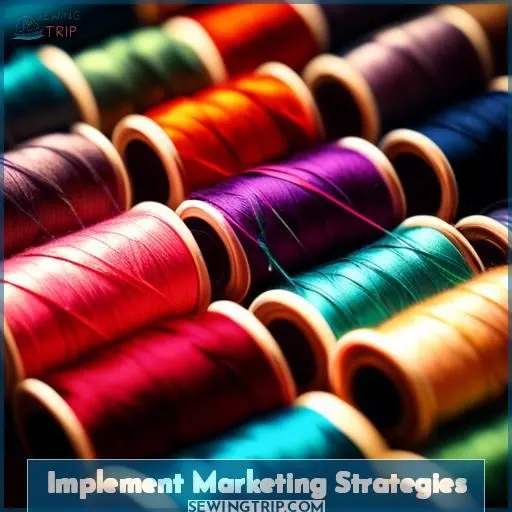This site is supported by our readers. We may earn a commission, at no cost to you, if you purchase through links.

To advertise your sewing business effectively, you need to define your target audience, set clear marketing goals, choose the right marketing channels, and implement effective marketing strategies.
Your target audience can include various age ranges, genders, locations, and sewing preferences. Your marketing goals should be precise, with quantifiable metrics, aligned with your target audience, and aimed at achieving objectives such as brand recognition, lead generation, or sales.
Marketing channels can include social media platforms like Instagram and Pinterest, email marketing, blogging, influencer collaborations, and local events. Your unique selling proposition should highlight your niche, value proposition, brand differentiation, competitive advantage, and brand recognition.
Marketing strategies should involve content planning, brand consistency, performance monitoring, result analysis, and experimentation with different approaches. To promote your sewing business, you can use high-quality images and detailed descriptions on your website, perform market research, make a plan, try social media, build a business website, and attend local events.
Table Of Contents
Key Takeaways
- Identify your target audience by considering age range, gender, location, and sewing preferences to tailor your marketing strategies.
- Set SMART marketing goals that align with your target audience and marketing channels, such as enhancing brand recognition, generating leads, or increasing sales.
- Choose the right marketing channels, including social media, email marketing, blogging, influencer collaborations, and local events, to reach your target audience effectively.
- Implement marketing strategies that involve content planning, brand consistency, performance monitoring, result analysis, and experimentation with different approaches to promote your sewing business.
How to Advertise My Sewing Business?
To advertise your sewing business, consider using a combination of social media platforms, such as Facebook, Instagram, YouTube, Pinterest, and Twitter. Engage with your audience by responding to comments and questions promptly, and maintain a consistent brand image across all platforms. Additionally, create quality content that showcases your products or services, and use storytelling in your posts to build relationships with potential customers. Perform market research to determine the most effective promotion methods for your business, and consider creating a website to promote your products and services. Finally, try guerrilla marketing tactics, such as free sewing classes at local events, setting up tables outside your studio, and partnering with similar businesses to create loyalty card systems.
Define Your Target Audience
To successfully promote your sewing business, it’s essential to identify your target audience. This involves comprehending the age range, gender differences, location considerations, and sewing preferences of your potential customers. By doing so, you can customize your marketing strategies to better resonate with your audience, enhancing brand recognition and increasing sales.
For example, if your business targets a younger demographic, you might consider focusing on social media platforms like Instagram and Pinterest, where younger users are more likely to be active. Additionally, you can create engaging content such as sewing tutorials, style guides, and behind-the-scenes videos to connect with your audience.
Set Your Marketing Goals
Establishing marketing objectives is a vital step in promoting your sewing business. Your goals should be precise, quantifiable, achievable, applicable, and time-sensitive (SMART). They should align with your target audience and marketing platforms.
Identify your targets, such as enhancing brand recognition, creating leads, or increasing sales. Set metrics to monitor progress, such as website traffic, social media interactions, or sales figures. Establish milestones to mark progress towards your goals.
Choose Your Marketing Channels
To effectively promote your sewing business, you need to choose the right marketing channels. Here are some steps to help you do that:
- Define your target audience: Age, gender, location, sewing preferences.
- Set your marketing goals: Increase brand awareness, generate leads, boost sales.
- Choose marketing channels: Social media, email marketing, blogging, influencer collaborations, local events.
- Develop compelling content: Sewing tutorials, style guides, behind-the-scenes videos, customer testimonials.
- Implement marketing strategies: Schedule and execute strategies, maintain brand consistency.
Remember to:
- Use high-quality images and detailed descriptions on your website.
- Conduct hashtag research and use follow-and-share strategies on social media.
- Schedule content, performance, and interaction on social media.
- Use live video to connect with your audience.
- Share user-generated content.
By following these steps and selecting the right marketing channels, you can effectively promote your sewing business and reach your target audience.
Choose Marketing Channels
Choose the right marketing channels to reach your target audience effectively. Consider social media platforms like Instagram and Pinterest for discovery, email marketing for direct communication, content marketing for educational content, and local events for in-person interactions. Remember to track your progress and adjust your strategies accordingly.
Develop Unique Selling Proposition
To distinguish yourself in the competitive sewing market, you need a distinct selling proposition (USP) that sets your brand apart. Determine your niche and target audience, then develop a value proposition that resonates with their requirements. This will provide you with a competitive advantage and raise brand recognition.
Implement Marketing Strategies
Question: Time to roll up your sleeves and plunge into the marketing mix! Craft a marketing calendar that’s as precise as your stitching, ensuring content scheduling is on point.
Reach out to influencers who can interweave your story into the social fabric. Listen attentively to your audience’s discourse, and seize collaboration opportunities.
Integrate user-generated content into your business website for an authentic touch.
Develop Compelling Content
Now that you’ve chosen your marketing channels and developed your unique selling proposition, it’s time to create compelling content that will engage your target audience. Sewing tutorials, style guides, and behind-the-scenes videos are great ways to showcase your skills and expertise.
Customer testimonials can help build trust and credibility with potential customers. Influencer collaborations can expand your reach and tap into new audiences.
Don’t forget about social media platforms like Facebook, Pinterest, and YouTube. Use ads to target your audience and sponsor content to increase visibility.
Implement Marketing Strategies
Implementing marketing strategies is vital for advancing your sewing business. Here are four steps to assist you in getting started:
- Plan strategies: Prepare your content and initiatives ahead of time. Utilize a calendar or task management tool to coordinate your responsibilities and timelines.
- Maintain consistency: Preserve the coherence of your branding and messaging across all platforms. This fosters confidence and recognition with your audience.
- Monitor performance: Regularly assess your metrics to discern what’s effective and what’s not. Employ analytics tools to gauge engagement, reach, and conversions.
- Analyze results and adjust strategies: Guided by your performance data, modify your marketing plan. Experiment with various approaches, patterns, and promotional tactics to determine what resonates with your target audience.
Frequently Asked Questions (FAQs)
What are the most effective social media platforms for promoting a sewing business?
The most effective social media platforms for promoting a sewing business are Facebook, Instagram, YouTube, Pinterest, and Twitter.
Facebook is great for reaching potential customers, posting content, and interacting with customers.
Instagram, as a visual platform, allows businesses to showcase their products and engage with potential customers.
YouTube is ideal for showcasing products and services through videos, providing tutorials, and targeting specific audiences.
Pinterest is useful for showcasing products, tutorials, and customer photos, driving traffic to your website, and engaging with potential customers.
Twitter is a great platform for reaching out to customers, engaging in conversations, and showcasing products.
How can I create a compelling content strategy for my sewing business?
To create a compelling content strategy for your sewing business, start by understanding your target audience. Define their age, gender, location, and sewing preferences.
Then, set marketing goals such as increasing brand awareness, generating leads, and boosting sales. Choose marketing channels like social media, email marketing, blogging, influencer collaborations, and local events.
Develop content that showcases your sewing tutorials, style guides, behind-the-scenes videos, and customer testimonials. Schedule and execute your strategies, maintaining brand consistency.
Use social media platforms like Instagram and Pinterest for discovery, conduct hashtag research, and use follow-and-share strategies. Schedule content, performance, and interaction, and use live video to connect with your audience.
Share user-generated content and collaborate with businesses offering similar products. Remember, content is king in marketing, and a well-planned strategy can markedly enhance your business growth.
What are the best ways to collaborate with influencers to promote my sewing business?
To collaborate with influencers and promote your sewing business, you should:
- Identify the right influencers: Look for influencers who specialize in sewing and have a high engagement rate and a large following. You can use platforms like Collabstr to browse top Sewing influencers by category or niche.
- Reach out to influencers: Don’t wait for influencers to approach you. Be proactive and reach out to them with a clear and concrete proposal, detailing what you have to offer and what you expect in return.
- Be genuine and authentic: Form genuine relationships with influencers and be true to your brand’s values. Your followers trust you to have their best interests at heart, and honest influencers tend to come across as just another customer rather than a paid spokesperson.
- Provide incentives: Offer incentives for influencers to promote your brand, such as free products, commissions on sales, or other forms of compensation.
- Comply with regulations: Ensure that you properly disclose your relationship with influencers and adhere to the regulations of different platforms.
- Collaborate on content: Work with influencers to create compelling content that resonates with their audience and showcases your sewing skills.
- Host events: Host events and invite influencers to attend and promote your brand. This can be a great way to boost brand exposure and attract a large number of influencers.
How can I measure the success of my sewing business marketing efforts?
To measure the success of your sewing business marketing efforts, you should track key performance indicators (KPIs) such as:
Customer satisfaction rate
Revenue generated from workshops and custom sewing services
The number of custom sewing orders
By monitoring these metrics, you can identify trends, assess the effectiveness of your marketing strategies, and make data-driven decisions to optimize your business operations.
Additionally, consider using social media analytics tools to track engagement, reach, and conversion rates for your social media campaigns.
What are the key elements of a successful sewing business marketing plan?
To create a successful marketing plan for your sewing business, consider the following key elements:
- Understand your target market: Define your ideal customer, including age, gender, location, and sewing preferences.
- Set marketing goals: Determine your objectives, such as increasing brand awareness, generating leads, or boosting sales.
- Choose marketing channels: Utilize social media, email marketing, blogging, influencer collaborations, and local events to promote your business.
- Develop compelling content: Create tutorials, style guides, behind-the-scenes videos, and customer testimonials to engage your audience.
- Implement marketing strategies: Schedule and execute your strategies, maintaining brand consistency across all channels.
- Track and measure success: Use analytics tools to monitor the performance of your marketing efforts and adjust your strategy as needed.
Conclusion
Jumpstart Your Sewing Business Success: Target Audience, Marketing Channels & Strategies
To effectively advertise your sewing business, start by defining your target audience and setting clear marketing goals. Choose the right marketing channels, such as social media, email marketing, and local events, and develop a unique selling proposition that highlights your niche and competitive advantage. Implement marketing strategies that involve content planning, brand consistency, performance monitoring, and result analysis. By following these steps, you’ll be on your way to promoting your sewing business and achieving your desired outcomes.











